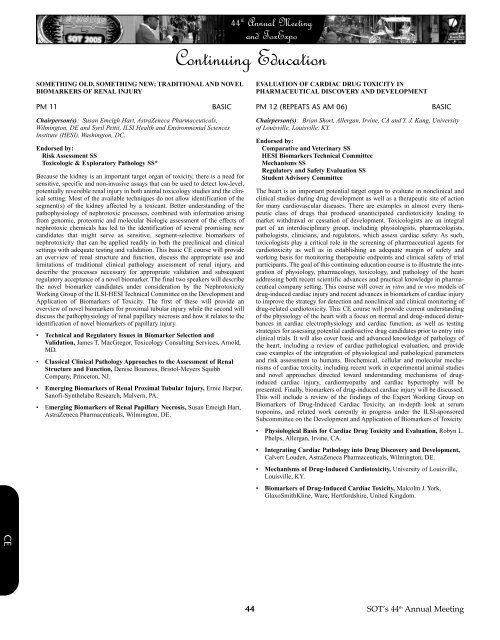Program - Society of Toxicology
Program - Society of Toxicology
Program - Society of Toxicology
You also want an ePaper? Increase the reach of your titles
YUMPU automatically turns print PDFs into web optimized ePapers that Google loves.
44 th Annual Meeting<br />
and ToxExpo<br />
Continuing Education<br />
SOMETHING OLD, SOMETHING NEW; TRADITIONAL AND NOVEL<br />
BIOMARKERS OF RENAL INJURY<br />
PM 11<br />
BASIC<br />
Chairperson(s): Susan Emeigh Hart, AstraZeneca Pharmaceuticals,<br />
Wilmington, DE and Syril Pettit, ILSI Health and Environmental Sciences<br />
Institute (HESI), Washington, DC.<br />
Endorsed by:<br />
Risk Assessment SS<br />
Toxicologic & Exploratory Pathology SS*<br />
Because the kidney is an important target organ <strong>of</strong> toxicity, there is a need for<br />
sensitive, specific and non-invasive assays that can be used to detect low-level,<br />
potentially reversible renal injury in both animal toxicology studies and the clinical<br />
setting. Most <strong>of</strong> the available techniques do not allow identification <strong>of</strong> the<br />
segment(s) <strong>of</strong> the kidney affected by a toxicant. Better understanding <strong>of</strong> the<br />
pathophysiology <strong>of</strong> nephrotoxic processes, combined with information arising<br />
from genomic, proteomic and molecular biologic assessment <strong>of</strong> the effects <strong>of</strong><br />
nephrotoxic chemicals has led to the identification <strong>of</strong> several promising new<br />
candidates that might serve as sensitive, segment-selective biomarkers <strong>of</strong><br />
nephrotoxicity that can be applied readily in both the preclinical and clinical<br />
settings with adequate testing and validation. This basic CE course will provide<br />
an overview <strong>of</strong> renal structure and function, discuss the appropriate use and<br />
limitations <strong>of</strong> traditional clinical pathology assessment <strong>of</strong> renal injury, and<br />
describe the processes necessary for appropriate validation and subsequent<br />
regulatory acceptance <strong>of</strong> a novel biomarker. The final two speakers will describe<br />
the novel biomarker candidates under consideration by the Nephrotoxicity<br />
Working Group <strong>of</strong> the ILSI-HESI Technical Committee on the Development and<br />
Application <strong>of</strong> Biomarkers <strong>of</strong> Toxicity. The first <strong>of</strong> these will provide an<br />
overview <strong>of</strong> novel biomarkers for proximal tubular injury while the second will<br />
discuss the pathophysiology <strong>of</strong> renal papillary necrosis and how it relates to the<br />
identification <strong>of</strong> novel biomarkers <strong>of</strong> papillary injury.<br />
• Technical and Regulatory Issues in Biomarker Selection and<br />
Validation, James T. MacGregor, <strong>Toxicology</strong> Consulting Services, Arnold,<br />
MD.<br />
• Classical Clinical Pathology Approaches to the Assessment <strong>of</strong> Renal<br />
Structure and Function, Denise Bounous, Bristol-Meyers Squibb<br />
Company, Princeton, NJ.<br />
• Emerging Biomarkers <strong>of</strong> Renal Proximal Tubular Injury, Ernie Harpur,<br />
San<strong>of</strong>i-Synthelabo Research, Malvern, PA.<br />
• Emerging Biomarkers <strong>of</strong> Renal Papillary Necrosis, Susan Emeigh Hart,<br />
AstraZeneca Pharmaceuticals, Wilmington, DE.<br />
EVALUATION OF CARDIAC DRUG TOXICITY IN<br />
PHARMACEUTICAL DISCOVERY AND DEVELOPMENT<br />
PM 12 (REPEATS AS AM 06)<br />
BASIC<br />
Chairperson(s): Brian Short, Allergan, Irvine, CA and Y. J. Kang, University<br />
<strong>of</strong> Louisville, Louisville, KY.<br />
Endorsed by:<br />
Comparative and Veterinary SS<br />
HESI Biomarkers Technical Committee<br />
Mechanisms SS<br />
Regulatory and Safety Evaluation SS<br />
Student Advisory Committee<br />
The heart is an important potential target organ to evaluate in nonclinical and<br />
clinical studies during drug development as well as a therapeutic site <strong>of</strong> action<br />
for many cardiovascular diseases. There are examples in almost every therapeutic<br />
class <strong>of</strong> drugs that produced unanticipated cardiotoxicity leading to<br />
market withdrawal or cessation <strong>of</strong> development. Toxicologists are an integral<br />
part <strong>of</strong> an interdisciplinary group, including physiologists, pharmacologists,<br />
pathologists, clinicians, and regulators, which assess cardiac safety. As such,<br />
toxicologists play a critical role in the screening <strong>of</strong> pharmaceutical agents for<br />
cardiotoxicity as well as in establishing an adequate margin <strong>of</strong> safety and<br />
working basis for monitoring therapeutic endpoints and clinical safety <strong>of</strong> trial<br />
participants. The goal <strong>of</strong> this continuing education course is to illustrate the integration<br />
<strong>of</strong> physiology, pharmacology, toxicology, and pathology <strong>of</strong> the heart<br />
addressing both recent scientific advances and practical knowledge in pharmaceutical<br />
company setting. This course will cover in vitro and in vivo models <strong>of</strong><br />
drug-induced cardiac injury and recent advances in biomarkers <strong>of</strong> cardiac injury<br />
to improve the strategy for detection and nonclinical and clinical monitoring <strong>of</strong><br />
drug-related cardiotoxicity. This CE course will provide current understanding<br />
<strong>of</strong> the physiology <strong>of</strong> the heart with a focus on normal and drug-induced disturbances<br />
in cardiac electrophysiology and cardiac function, as well as testing<br />
strategies for assessing potential cardioactive drug candidates prior to entry into<br />
clinical trials. It will also cover basic and advanced knowledge <strong>of</strong> pathology <strong>of</strong><br />
the heart, including a review <strong>of</strong> cardiac pathological evaluation, and provide<br />
case examples <strong>of</strong> the integration <strong>of</strong> physiological and pathological parameters<br />
and risk assessment to humans. Biochemical, cellular and molecular mechanisms<br />
<strong>of</strong> cardiac toxicity, including recent work in experimental animal studies<br />
and novel approaches directed toward understanding mechanisms <strong>of</strong> druginduced<br />
cardiac injury, cardiomyopathy and cardiac hypertrophy will be<br />
presented. Finally, biomarkers <strong>of</strong> drug-induced cardiac injury will be discussed.<br />
This will include a review <strong>of</strong> the findings <strong>of</strong> the Expert Working Group on<br />
Biomarkers <strong>of</strong> Drug-Induced Cardiac Toxicity, an in-depth look at serum<br />
troponins, and related work currently in progress under the ILSI-sponsored<br />
Subcommittee on the Development and Application <strong>of</strong> Biomarkers <strong>of</strong> Toxicity.<br />
• Physiological Basis for Cardiac Drug Toxicity and Evaluation, Robyn L.<br />
Phelps, Allergan, Irvine, CA.<br />
• Integrating Cardiac Pathology into Drug Discovery and Development,<br />
Calvert Louden, AstraZeneca Pharmaceuticals, Wilmington, DE.<br />
• Mechanisms <strong>of</strong> Drug-Induced Cardiotoxicity, University <strong>of</strong> Louisville,<br />
Louisville, KY.<br />
• Biomarkers <strong>of</strong> Drug-Induced Cardiac Toxicity, Malcolm J. York,<br />
GlaxoSmithKline, Ware, Hertfordshire, United Kingdom.<br />
CE<br />
44<br />
SOT’s 44 th Annual Meeting

















